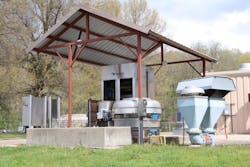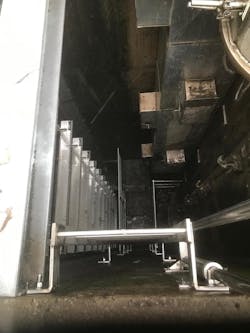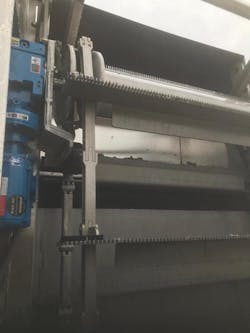About the author:
Shaun O’Kelley is water division engineer for KC Water. O’Kelley can be reached at [email protected].
Kansas City is a dynamic metropolis on the banks of the Missouri River, home to nearly half a million residents — and a constant stream of visitors coming to enjoy the world-class barbecue and music scene. All that activity puts steady pressure on the city’s water and wastewater infrastructure. KC Water is the utility charged with meeting those needs.
Like other U.S. cities, KC Water is in the process of implementing a 25-year, federally mandated Overflow Control Program (OCP). The program, called Smart Sewer, has received national attention for being among the first to incorporate significant green solutions. This multi-billion-dollar initiative includes extensive sewer rehabilitation and “green infrastructure” projects, all aimed at reducing sewer overflows during periods of heavy rain or snow melt.
As part of its comprehensive approach to preventing overflows, enhancing water quality and service reliability, KC Water is also investing in capital improvement projects. One such upgrade greatly impacted wastewater treatment compliance and efficiency, simply by effectively removing debris at the headworks before it could impact downstream plant operations.
System Size & Population
KC Water’s wastewater collection and treatment system serves more than 166,000 customers across a 320-square-mile area within and beyond the city limits. The utility is responsible for six wastewater treatment plants, 40 wastewater pump stations and 2,800 miles of sewer mains for a combined rated treatment capacity of 150 million gallons per day (mgd). All wastewater transported to KC Water receives secondary treatment to remove residual organics and suspended solids in compliance with federal and state environmental regulations.
Built in 1968, The Todd Creek Wastewater Treatment Plant is designed to handle an average flow of 3 mgd with a peak capacity of 5.5 mgd. Substantially renovated and expanded in 1990, the activated sludge process plant features an influent pump station, holding cells for primary sedimentation, concentric aeration basins, clarifiers and a UV facility that disinfects treated effluent before it is discharged into the adjacent Todd Creek, a tributary of the Little Platte River. The plant services more than 7,500 customers in the Northwest region of the city, including Kansas City International Airport, which served nearly 11.8 million travelers in 2019.
Debris in the Influent
The plant was experiencing high levels of debris in the influent, including flushable wipes, rags, female hygiene products, plastic bottles, cigarette butts, scrap wood and even clothing items generated by travelers at the airport.
When the facility was built in 1968 it was equipped with a comminutor, which was replaced with a new grinder during the 1990 upgrade of the plant. Rather than remove debris, the channel grinder was designed to shred it into small pieces and keep it in the waste stream. This strategy proved inadequate in several ways.
The shredded debris would reconstitute downstream, creating basketball-sized clumps that caused considerable maintenance throughout the plant. This debris would get caught on pumps, on bubblers, and on the UV bulbs, ultimately clogging pumps. Manual removal of ground up debris in downstream equipment accounted for at least an hour of the staffs’ time and two to four buckets of trash daily.
In addition, the grinder routinely became clogged or shut down due to a low hydraulic fluid level, often multiple times a week. This downtime created a backup of influent, and disrupted plant operation. Technicians had to be dispatched to the plant to clear the grinder and perform maintenance on the unit.
Another problem emerged when rain and snow melt raised the level of influent at the headworks, up to 18 feet above the normal level in some cases. The grinder was located down in the channel, which was only 4 feet deep. Yet during rain events, the water level would rise well above this, allowing debris to bypass the grinder completely. Again, this required manual removal by
the staff.
In addition to impacting plant operations and consuming valuable staff time, these debris infiltrations threatened the plant’s compliance for levels of total dissolved solids (TDS), the dissolved inorganic and organic substances; total suspended solids (TSS), a measure of inorganic and organic substances that are not dissolved; and biochemical oxygen demand (BOD), a key measure of biodegradable material in the treated effluent.
Choosing a Bar Screen
Recognizing the need for a more effective solution for removing debris, KC Water engineers believed a wastewater bar screen would provide the answer.
Plant engineers looked at bar screen products from two leading vendors. Following an in-depth review of the designs, features, and field history of the systems, the utility selected the Duperon FlexRake automated bar screen.
A key advantage of this screen is its design featuring FlexLink — rated at 60,000 pounds — and Jam Evasion Technology. When it encounters large debris, the lower portion of the bar screen can pivot out to accommodate the object and transfer it up the screen without causing a jam or requiring operator intervention. By contrast, the previous unit featured a fixed lower sprocket, reversing the cleaning motion in an attempt to clear the object. This could interrupt operations or require manual debris removal if the jam is not
successfully removed.
KC Water has installed the automated bar screens at two other facilities previously. This experience, together with the technology’s more than 25-year application history, installed base of nearly 2,000 units, and the expertise and responsiveness of the Duperon engineering team were key factors in the utility’s decision to install one at Todd Creek.
Bar Screen Customization
The FlexRake can be customized to fit a variety of site configurations. To accommodate the high water events at the Todd Creek plant, the Duperon team designed a vertical unit measuring 5.5 feet wide by 34 feet high. To further safeguard against overflows, plant management installed a bypass and manual screen with 0.25-inch openings. Engineering at the site was performed by Brown & Root Industrial Services of Kansas City.
The automated bar screen currently deposits debris into a wheeled dumpster that is emptied approximately twice per week. The plant is installing a shaftless screw conveyor to further automate
debris management.
Since the unit went operational in July 2020, the staff reported significant improvements in operational efficiency. The unit is highly effective at removing the rags and other debris that formerly caused so many problems, dramatically improving downstream operation.
Plant operators estimate that it removes 90% of all incoming debris, eliminating the problem of rags, plastic and other items clogging pumps or passing into the clarifier. Daily maintenance of draft tubes has been reduced about 65%, and the UV disinfection bulbs require far less cleaning. Overall, plant operators report debris-related maintenance has been substantially reduced since the FlexRake was installed.
Now, the Todd Creek plant is able to remove the trash from the plant, rather than just grinding it as they did before. It is estimated that the FlexRake is preventing about 99% of the trash, including items like cigarette butts and soda straws, from entering downstream processes.
Both the bar screen and the company behind it proved to be reliable. Soon after installation, there was an issue with a motor bearing. Duperon responded quickly, replacing the component and getting the equipment back online with minimal disruption. The FlexRake operates 24/7 and plant operators report flawless operation.
Achieving a Platinum Rating
The Todd Creek plant has a good history of compliance with water quality requirements for its discharge. Since deploying the FlexRake, this has only improved, taking the plant from its typical Silver or Gold rating to the highest Platinum rating.
All critical quality measures have now been reduced to “non-detect” levels, including TDS, TSS and BOD. This is a significant result, as the plant’s discharge permit allows daily amounts of TDS of up to 5.3 mg/L (April 1 to September 30) and 12.1 mg/L (October 1 to March 31).
“The FlexRake really helps with our clarifier and our compliance,” said Margaret Wilson, KC Water plant operator. “We have two other Platinum plants and we could never compete with them until we got the FlexRake.”


